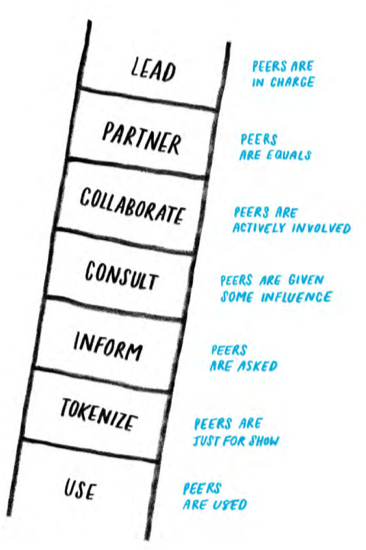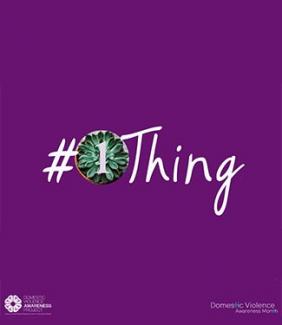by Casey Keene of the National Resource Center on Domestic Violence
In my neighborhood, I sit at a variety of tables convened by groups who all ultimately share a common goal of promoting our community’s health and well-being. While there are differences in the makeup of the groups and the strategies they pursue, there are some fundamental similarities across all of them. One is that no matter how many people are sitting at the table, only a small handful will commit to, and follow through with, taking action.
I have often marveled at this, wondering what motivates some to take action, and others not. Because frankly, while showing up is important, the change we wish to see requires each of us to do more.
- Are people feeling overwhelmed by all that needs to be done, and are therefore paralyzed?
- Are they fearful that committing to one thing will open a door they cannot close?
- Do people assume that what they can offer will not make a difference?
If nobody takes action, there is no movement. But action takes courage. How can we learn from those who do to inspire those who do not?
“The path to big, systemic change is collective action. That takes Sister Courage.” – Gloria Feldt
What motivates people to take action?
Action makes us feel like we matter. “Research steadily finds that when we are able to recognize, imagine, and trace the impact of even our smallest actions on other people in our lives and work, we experience a greater sense of meaning and purpose” (Mercurio, 2017).
Why is this so important? The science of mattering has been the subject of great attention by resilience researchers in recent years, who are finding that mattering is critical on the path to healing and resilience after trauma and other adversities. Dr. Isaac Prilleltensky of the University of Miami describes this as a reciprocal relationship, in which people come to feel that they matter when they both derive value from and add value to themselves, their relationships, and their community. In other words, when people take action to invest in the well-being of others, they themselves feel greater personal well-being.
Because of its connection to healing and resilience, taking action can be especially impactful for those who have experienced injustice and oppression. Plan to Thrive, a resource dedicated to activist health and wellbeing, received nearly 200 responses to a survey that asked, among other questions, “What motivates you to engage in activism?” Responses (some highlighted below) revealed that many felt compelled to act based on their personal stories and identity. In this way, action is a strategy for both personal healing, and for changing social circumstances to protect others from experiencing adversity.
“Personal experiences with stigma and discrimination. Grew into accountability to the rest of humanity…
shifting beyond my individual needs and a re-centering on the voices/work of individuals facing the most
violence from intersecting identities.” (Plan to Thrive survey respondent)
Action keeps us connected to community. Additionally, Plan to Thrive uncovered activists’ motivation to unite in passion, empathy, and responsibility. People want to be part of something larger than themselves – contributing to something they feel is making a positive change. It’s about connectedness and belonging, which are fundamental human needs that also happen to promote resilience and well-being.
“My tag line is ‘raising the level of love in the world.’ I want to make the world a better place.”
(Plan to Thrive survey respondent)
Some have noted that “caring about the world is also self-care” (Lewis, 2017), describing this concept more broadly as community care:
“Not only can protesting be self-care because it helps you speak your truth, but it fosters connection
and community care — a concept that is basically self-care on, well, a community level” (Rodriguez-Cayro, 2018).In short, we take action because we care about, and are invested in, our communities.
Action inspires hope. In a recent Technical Assistance Question (TAQ), Ivonne Ortiz refers to hope as the fuel for our human hearts. She describes hope as a motivator driving our social change work and explores how activists can be messengers of hope to help our communities see their strengths, possibilities, and solutions through collaboration. Breckan Erdman further explored this concept when she noted that “seeing positive changes in our communities can encourage us to feel more hopeful and can help fuel the passion that brought us to this work in the first place.” It is a cycle that has no beginning and no end. Action inspires hope, and hope inspires action.
“I enjoy meaningful work. Being involved in activism makes me feel like I have power to effect change.”
(Plan to Thrive survey respondent)
Starting with one thing (when there is so much to do!)
This year’s message for Domestic Violence Awareness Month expands on the Awareness + Action = Social Change campaign, which emphasizes the importance of “being part of the equation” to end domestic violence by engaging in proactive efforts to shift our culture. By encouraging people to do #1Thing, we acknowledge that everyone has a role to play, no matter how small, in our collective effort.
It’s easy to feel overwhelmed by the injustices happening in our communiites everyday. But when you start with just one thing, it inspires others to also do one thing, and together you begin to realize the collective power we have to achieve real social transformation.
One thing can be simple. Futures Without Violence’s Changing Minds project explores the science behind childhood trauma and how simple “everyday gestures” can be the key to promoting healing and resilience in children who experience adversity and child traumatic stress. They note, “Every time you connect with a child to talk and listen to them, comfort and celebrate them, or inspire and collaborate together with them, you help to build their ‘adaptive toolkit’ that they can access to face adversity” (Futures Without Violence).
There is a body of evidence that demonstrates the profound impact that “everyday gestures” can have on children’s healthy development – including actual physical changes to their brain as it heals from trauma. The Changing Minds project offers 5 key gestures including celebrating, comforting, collaborating, listening, and inspiring. While applied to children in this context, these gestures promote the health and well-being of people of all ages. This evidence-based approach is embraced by the Thrive Foundation for Youth and the Center for Evidence-Based Mentoring’s Everyday Mentor resource, and applied in the Indiana Coalition Against Domestic Violence’s Small Moments campaign.
These initiatives offer examples of how being a change maker can fit easily into our lives, especially when the actions align with your own core values. Sometimes we don't realize that the very ways we already live involve actions that profoundly impact the lives of others. If we shed light on those actions and how they make a difference, moving people to action can be as simple as bringing intentionality and commitment to a journey they are already on.
One thing can be more. For those who are motivated and have the privilege of time and resources to do more, it’s helpful to point people to concrete ways their energy can be best utilized. The handout 13 Ways Any Adult Can Make Ending Domestic Violence His or Her Business offers some helpful strategies. Additionally, the Special Collection, Open Doors: Thinking Beyond Shelter (Or Alternative Ways to Help Survivors) provides considerations and ideas for how people with a variety of skill sets and areas of expertise can offer their talents to advance our movement. For those who benefit from white privilege, model what it looks like to take a stand against racism and other forms of injustice. Take risks. Speak up. Leverage your privilege to impact change in your interactions with individuals, and in your spheres of influence including community groups, institutions, and systems of which you are a part.
Collective power and its impact on community health
Once people are engaged, you can “build a collection of awesomeness” to make real change in your community. The relationships that are built from intentional and meaningful community engagement with diverse partners that represent the true makeup of your community are the very thing that will advance our movement’s vision. As Ivonne Ortiz describes, “This ‘collection of awesomeness’ is what increases a community’s collective power to engage in social change.” Efforts to end domestic violence are most effective when they are driven by the community itself.

“We need to acknowledge that we can tokenize people in engagement.”
(Margins to Middle Participant)
Engagement from the margins to the center is a key strategy for addressing and preventing domestic violence in ways that best promote health, equity, and justice in your community. We must embrace a “nothing about us without us” approach to our community engagement efforts, insisting that efforts to create our programs, policies, and practices include the full and direct participation of those most impacted. Based on the ladder of engagement framework utilized by many organizations to deepen engagement one step at a time, the Centre for Addiction and Mental Health offers an adapted version of the ladder in their health equity kit, From the Margins to the Middle (2015). This peer engagement ladder illustrates the various levels of influence that engagement can take, including those that can cause harm. It’s important to consider the ways in which the engagement opportunities we offer can impact individuals, either positively or negatively.
People want to feel like they matter, that they are connected to their community, and that there is hope in moving forward. If we are able to show people how their “one thing” adds value to creating and sustaining healthy communities, we can accomplish the social transformation necessary to achieve a world that is peaceful, equitable, and just.
What is your one thing?
Share your #1Thing this Domestic Violence Awareness Month and beyond, to help shed light on:
- The value of each action, no matter its size, on impacting social change;
- The strength and perseverance of change makers in the face of challenging times;
- The impact we can have on both individual and community journeys of healing and resilience;
- The invaluable role we all play in creating the world we wish to live in; and
- The power of sharing our #1Thing as a strategy for raising awareness and inspiring change.
There are a variety of ways to join our collective effort and engage your spheres of influence around #1Thing. Visit the Domestic Violence Awareness Project’s Awareness Highlights Blog to learn more!
Resources and tools
The PreventIPV Tools Inventory offers resources to support your community engagement efforts. For example, Teaching for Change promotes civic engagement and social justice leadership for youth, the Brown Boi Project’s Toward Healthy and Whole engages trans and gender nonconforming bois of color, Te Invito is designed to engage and mobilize Latino men, and Athletes as Leaders empowers high school athletes on girls’ sports teams to take an active role in promoting healthy relationships. Additionally, the Engagement section of the PreventIPV website explores approaches to new partnerships in the community, business, and health sectors.
Fuerza Unida (Strength United) describes the community engagement process that was the foundation for Casa de Esperanza’s changes in philosophy and strategy.
Forward Together has resources and tools to support community mobilization, civic engagement, and legislative advocacy.















